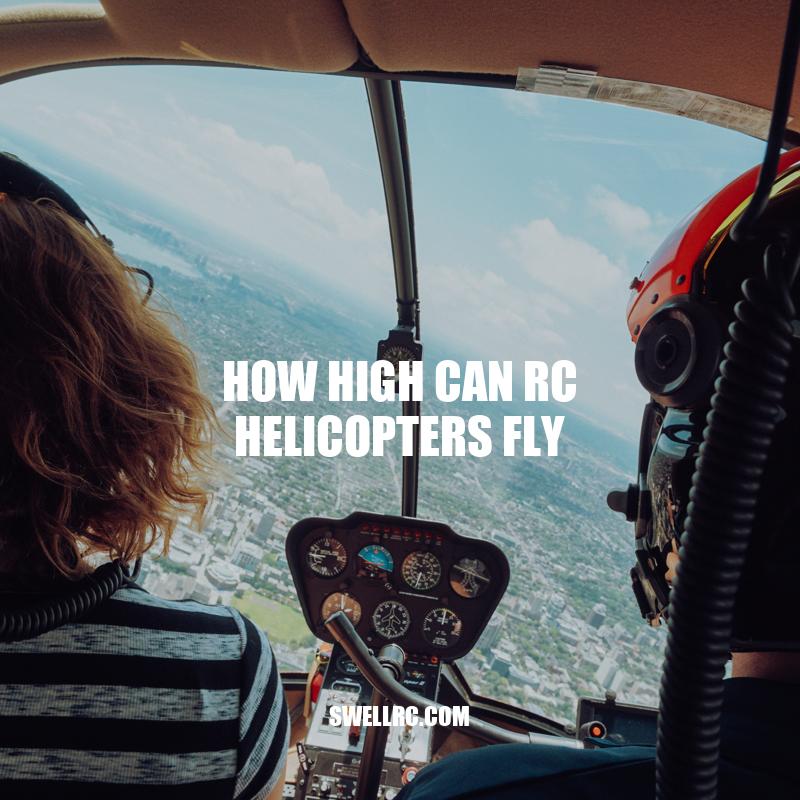How High Can RC Helicopters Fly: Understanding Limits and Factors
Remote control (RC) helicopters are popular toys for children and adults alike because they offer endless possibilities for entertainment and creativity. These small, maneuverable machines give us a chance to experience the thrill of flight from the ground. Whether you are an experienced hobbyist or just getting started, understanding the maximum height an RC helicopter can fly is an essential aspect of flying safely and effectively. The truth is that there are several factors that affect an RC helicopter’s ability to fly high, and understanding these factors can help you improve your overall flight experience. In this article, we’ll dive into those factors and discuss how you can maximize your RC helicopter’s altitude.
Understanding the Limits of RC Helicopter Altitude
There are various factors that impact the maximum altitude of an RC helicopter. Let’s explore these factors in detail:
- Battery life: The battery life of an RC helicopter determines its maximum altitude. A low battery can cause the helicopter to lose power, making it challenging to control and fly effectively. Factors such as battery quality, capacity, and age affect its overall lifespan.
- Controller range: The range of the controller is another critical factor that determines how high the helicopter flies. The remote control must have a clear line of sight with the helicopter to operate effectively.
- Atmospheric conditions: Windy weather, humidity, temperature, and air pressure all affect an RC helicopter’s performance. It’s essential to ensure that you fly your helicopter in optimal weather conditions for the best results.
Understanding these factors can help you maximize your RC helicopter’s altitude and ensure a better flying experience. You can check out websites like HorizonHobby.com for more information on how to improve your helicopter’s performance.
How high can a RC helicopter go?
RC helicopters can go as high as 400 feet (121m) or more depending on the model and weather conditions.
Factors that affect the maximum height of an RC helicopter include:
- Power of the motor and battery life
- Weight and size of the helicopter
- Wind speed and direction
- Controller range and interference
It’s important to always follow the manufacturer’s instructions and safety guidelines when operating an RC helicopter. Some popular RC helicopter brands include Blade, Syma and DJI.
If you’re looking to buy an RC helicopter, you can find them online on websites such as Amazon, Horizon Hobby, and Tower Hobbies.
Battery Life and Maximum Altitude
The battery life of an RC helicopter is vital for achieving maximum altitude. Here are some tips to help you improve your helicopter’s battery life and maximum altitude:
- Charge your battery correctly: Be sure to charge your battery following the manufacturer’s instructions. Overcharging or undercharging the battery can affect its overall lifespan.
- Invest in a high-capacity battery: A high-capacity battery can provide more power and improve your helicopter’s flight time, allowing it to reach higher altitudes.
- Reduce overall weight: Removing unnecessary weight from your helicopter can increase the battery’s life, improving its overall performance and altitude.
Did you know that the first RC helicopter was invented in 1969 by Dr. Dieter Schluter? Since then, RC helicopters have evolved to become more advanced, with better technology allowing them to fly longer and higher. You can check out websites like RC Helicopter Fun to learn more about RC helicopter technology and battery life.
How do you increase altitude in a helicopter?
To increase altitude in a helicopter, you need to follow these steps:
- First, you need to increase the RPM of the helicopter’s rotors.
- Next, you need to tilt the rotor disk forward slightly to create lift and move the helicopter upwards.
- Finally, you can use the cyclic and collective controls to maneuver the helicopter to the desired altitude.
For more information on helicopter controls and techniques, you can visit the Federal Aviation Administration’s website at www.faa.gov.
Controller Range and Maximum Altitude
The controller range for an RC helicopter is also a factor that affects its maximum altitude. Here are some tips to help you maximize your controller range and the helicopter’s altitude:
- Ensure line of sight between the helicopter and controller. This is critical since obstacles such as trees or buildings can interfere with the signal.
- Invest in a quality controller. Cheap controllers frequently have less range, less accuracy and less precision. Get a good quality controller, and you will have a better flying experience.
- Avoid interfering signals. Other signals can interfere with your controller’s signal, especially when it operates at the same frequency. Find channels with the least interference.
Some RC helicopters have a greater controller range than others, which can make them better suited for flying to higher altitudes. Check out websites like Amazon to learn about RC helicopters with extended controller range.
What is the range of a helicopter?
The range of a helicopter varies depending on several factors, such as fuel capacity, cruising speed, weight, and altitude. Some helicopters can travel over 1,000 miles without refueling, while others have a range of less than 200 miles.
Here are some examples of the range of popular helicopter models:
- Robinson R22: Range of 240 miles
- Bell 206B Jet Ranger: Range of 374 miles
- AgustaWestland AW139: Range of 570 miles
- Sikorsky S-76: Range of 411 miles
- Airbus H160: Range of 500 miles
If you want to learn more about helicopters, check out websites like Helicopter Online Ground School or Helicopter Association International. They provide detailed information about helicopter operation, maintenance, and safety.
Atmospheric Conditions and Maximum Altitude
The atmospheric conditions play a significant role in determining an RC helicopter’s maximum altitude. Below are some tips to navigate through the different atmospheric conditions and maximise the helicopter’s altitude:
- Watch the wind speed and direction. The presence of strong wind faster can make hovering and navigation difficult. Check the weather forecast before setting out to fly your helicopter.
- Maintain a comfortable temperature. Cold weather can significantly affect an RC helicopter’s battery life, reducing the maximum altitude. Practice insulating batteries and keeping them warm during flight.
- Watch the air pressure. Air pressure influences the air density, affecting the reach of your helicopter. Higher altitudes experience low air density, which reduces an RC helicopter’s altitude. Look for areas with higher air density to extend your helicopter’s reach.
There are many apps available to help RC helicopter owners determine the best weather conditions for flying. Some websites, like Dronezon, have compiled a list of the best weather apps for drones that can be used for RC helicopters. Research the apps and take note of the atmospheric conditions before flying your RC helicopter to maximise its altitude.
How does altitude affect helicopter performance?
- As altitude increases, the air gets thinner and provides less lift for the helicopter rotors.
- This means that helicopters have reduced lifting capacity and decreased speed at higher altitudes.
- High altitude also impacts the engine performance due to reduced air pressure and temperature.
- Helicopters flying at high altitude require more power and fuel to maintain lift and speed.
- Pilots must consider altitude when planning flight routes and carrying out maneuvers.
For more information on helicopter performance, check out aviation websites like FAA.gov or helicopter manufacturers like Airbus or Bell.
Legal Restrictions on RC Helicopter Altitude
In some countries and states, there are restrictions on how high RC helicopters can fly. Failing to comply with these restrictions can potentially result in legal consequences. Here are some examples of legal restrictions on RC helicopter altitude that you should be aware of:
- USA: In the United States, FAA (Federal Aviation Administration) regulations dictate that drones and RC helicopters must operate below 400 feet in altitude, and should not interfere with manned aircraft.
- Australia: The Civil Aviation Safety Authority (CASA) requires drone and RC helicopter operators to fly below 400 feet and have direct line of sight with the aircraft at all times.
- Japan: In Japan, drone and RC helicopter pilots must receive a certification to fly above 250 grams, and must request permission from relevant administrative bodies to fly above 150 meters or in public areas.
It’s always essential to research local laws and regulations before flying your RC helicopter to avoid any legal complications. If you’re unsure of the most recent regulations, contact your local aviation authority for clarification. Additionally, always ensure that you follow general RC helicopter safety guidelines to avoid accidents and injuries. Some websites like FAA’s UAS webpage provide detailed information about the legal and safety regulations surrounding the operation of RC helicopters and drones.
How low can a helicopter fly legally?
The minimum legal altitude for a helicopter is generally 500 feet above the ground, except for when taking off or landing. Helicopters can fly below 500 feet but only if the flight is necessary for safe landing, takeoff, or if it is being operated over open water. However, it’s still advisable to maintain a safe distance from the ground and other obstacles. The specific altitude restrictions can vary depending on the country and location.
For more information, you can visit the Federal Aviation Administration (FAA) website, which provides guidelines for aircraft operations in the US airspace.
Conclusion
In conclusion, the maximum altitude that an RC helicopter can fly is determined by several factors. Some of these factors include battery life, controller range, and atmospheric conditions, among others. Understanding these factors is essential for getting the most out of your RC helicopter and avoiding legal complications.
By taking proper care of your RC helicopter and following safety guidelines, you can significantly improve its performance and longevity. Additionally, it’s crucial to research local laws and regulations to avoid any legal complications when flying your helicopter.
Overall, an RC helicopter is an exciting and entertaining hobby that requires dedication and care. By incorporating the tips outlined in this article, you can maximize your helicopter’s height, performance, and longevity. Get ready to take your RC helicopter flying to new heights!



